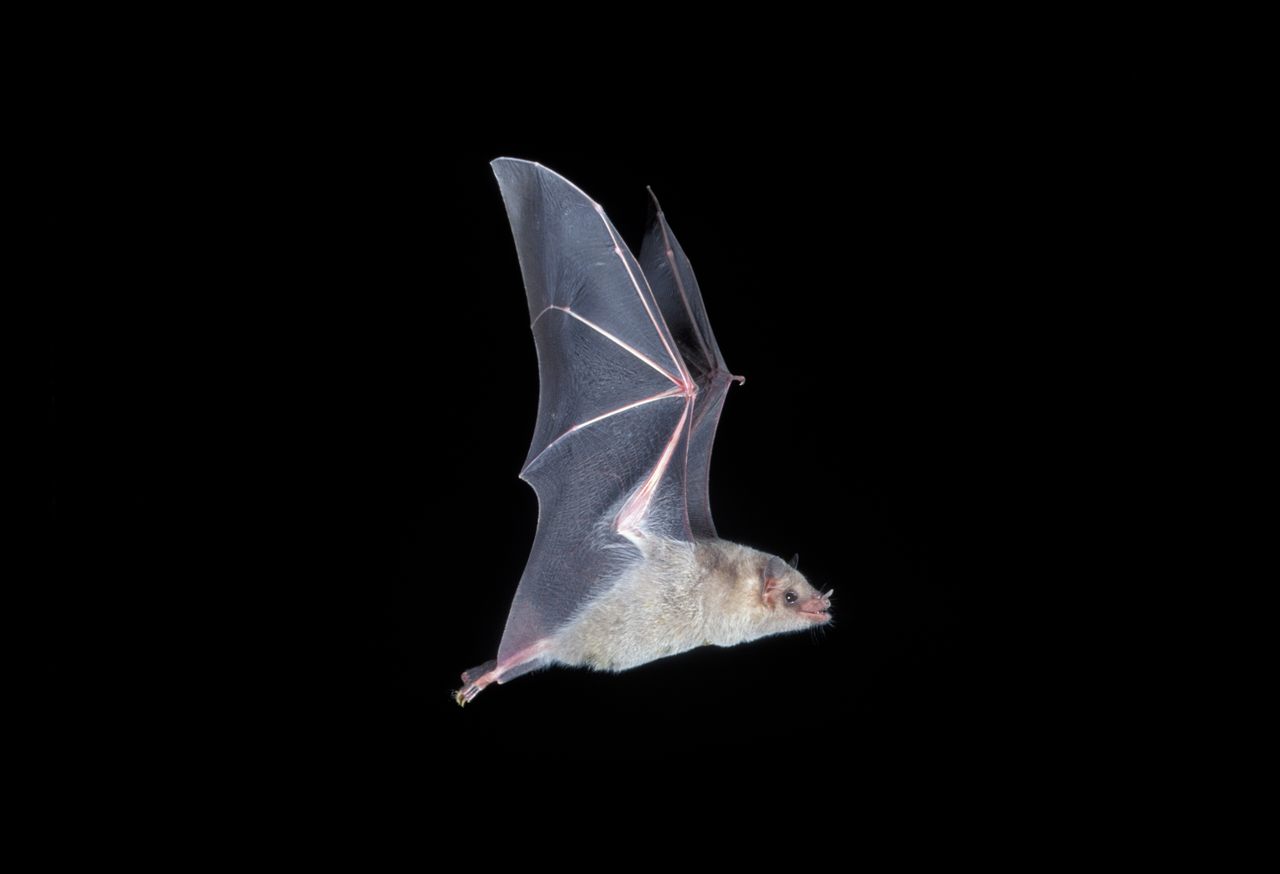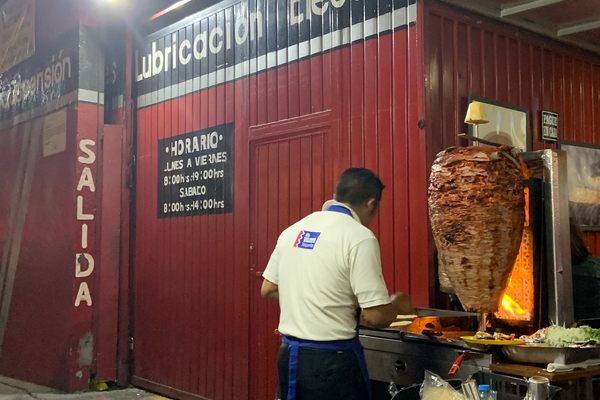How Preserving Agave Could Help Save an Endangered Bat
Conservationists hope to protect the Mexican long-nosed bat by working with ranchers and other locals to preserve the plant it needs.
This piece was originally published in Yale E360 and appears here as part of our Climate Desk collaboration.
At the southeast tip of a large valley in the northern Sierra Madre Oriental is the small Mexican town of Estanque de Norias, some 200 miles west of the Texas border at Laredo. Mountains rise up around the scrubby, treeless terrain like undulating brown walls. The star of this parched landscape is Agave asperrima, whose rosettes of impressive thick, blue-gray leaves edged with large, sharp teeth can grow four feet high and five feet wide. The agave spends its entire 10- to 15-year life storing enough sugars for the moment when it sends a massive flowering stalk up into the sky. The stalk, which can reach 20 feet tall, is topped by a giant, candelabra-like inflorescence with numerous flower clusters bearing countless small, bright yellow blooms that produce large quantities of sweet nectar at night. After flowering, the plant dies.
Estanque de Norias is an ejido, a communal agrarian community whose 300 inhabitants make their living in the desert scrub. The striking landscape offers barely enough to support the ejidatarios and their cattle in normal times, and climate change has made their living even more precarious. “One of the principal problems is the availability of water for the people and the cattle in the driest months,” says José Juan Flores-Maldonado, executive director of the Mexican nonprofit Species, Society, and Habitat—known by its Mexican acronym ESHAC. “Desertification, which is evident in a huge part of the area, is the key threat to human livelihoods and biodiversity in ejidos like Estanque de Norias.”
Harvesting agaves for the production of mezcal, including tequila, is not a major threat in northeastern Mexico, as it is in the western part of the country. However, as drought has intensified and become more frequent, the cattle, which have traditionally grazed on grasses and other native forage, have been forced to feed on agaves. The land is now so heavily grazed and degraded that the agaves are disappearing or are consumed by the cattle before they can flower, threatening another important denizen of the desert scrub, the endangered Mexican long-nosed bat.

The relationship between agaves and long-nosed bats—the plant’s main pollinator—is the product of thousands of years of coevolution. Because both the bats and the plants benefit from their relationship, it is a classic example of what biologists call a “mutualism.” In fact, they are considered keystone mutualists because their relationship is essential to the health and stability of their ecological communities. Agaves also serve as keystone species for human communities and have been an inextricable part of the culture and identity of the Mexican people for millennia.
“Conservation is also about people,” says Kristen Lear, who leads Bat Conservation International’s Agave Restoration Initiative. Along with Flores-Maldonado, Lear is part of a group of Mexican and American partners working on ways to enable the ejidatarios, the agaves, and the nectar-dependent bats to share the harsh landscape. “In situations like this where wildlife and people are tightly connected,” she says, “paying attention to human needs and engaging local people is just as important as studying wildlife needs.”
The project epitomizes a new kind of conservation that strives to preserve not just single species but rather mutualistic and keystone relationships. This outlook views local people as a key part of the web of interdependent, mutually beneficial relationships with other species, which is essential for the health of the land and the biodiversity and human livelihoods it supports.
From 2015 to 2018, Lear spent a lot of time in communities like Estanque de Norias doing field work for her doctorate in integrative conservation, which aims to combine the health of human communities with conservation goals. She was there to understand how the ejidatarios use and manage the agaves on their lands and to study the behavior of the secretive bat. Many nights she sat silently with an infrared camcorder under a sky spangled with stars, watching intently for nocturnal visitors to the towering stalks of nearby agaves. “Suddenly, the silence is interrupted by the whooshing sound of a small group of Mexican long-nosed bats rocketing into the area to sip the sugary liquid in the agave flowers,” says Lear. “For 10 or 15 or 20 minutes at a time they hit the agaves one after another. It’s magical.”

The largest nectar-feeding bat in North America, the Mexican long-nosed bat has an elongated muzzle with a prominent “nose leaf,” a small fold of skin, at the tip. The bat’s long nose and tongue, which can extend 3 inches, enable it to probe deep inside agave flowers for nectar. “The bats are just adorable,” says Francesca Claverie, head of the native plant nursery program at the Borderlands Restoration Network, which collaborates with Bat Conservation International (BCl) to grow agaves to support long-nosed bats. “They look like baby chihuahuas with a cute little nose.”
They are also highly endangered. Bat scientists suspect the species declined by more than 50 percent within a decade. Loss of roosting sites is one factor believed to be causing its swift downturn. For example, urbanization and increasing visits by tourists and speleology groups threaten the bat’s one known mating site, Cueva del Diablo, just outside Mexico City. From 2001 to 2010, standardized counts by Rodrigo Medellín of the Universidad Nacional Autónoma de México found 3,500 individuals. From 2017 to 2019, 2,000 bats were recorded at the cave, and in 2020 the number had dropped to 1,500.
Conservation efforts are complicated by the fact that many of the bats undertake a 700-mile migration between central Mexico and the southwestern United States each year. In March, pregnant females leave the mating site, where both sexes gather during winter, and follow the wave of blooming agave and cactus species north. During April, May, and early June, the females stop at four known maternity roosts in east and northeast Mexico and Big Bend National Park in Texas, where they give birth to a single “pup.” One of the roosts, Rosillo Cave, is just a few miles from Estanque de Norias, making the ejido a critical foraging site for hungry moms and their pups.
“The maternity roosts are where the moms raise the pups until they can fly, which is usually about six weeks,” Lear says. Some of the young and their mothers continue to follow the trail of blooms to a post-maternity cave in the southwestern corner of New Mexico. In late summer and fall, the bats follow the wave of late-blooming agaves back south.

Scientists believe that the loss of food sources along the so-called “nectar corridor” is a key cause of the bat’s demise. Nectar and pollen from agave plants are a primary food of the Mexican long-nosed bat — in northern stretches of the migration they are thought to be the only source. When the bats are in Texas, for example, they feed solely on one agave species, Agave havardiana, which is deemed vulnerable to extinction and declining on the Red List of imperiled species.
Unlike its close relative the lesser long-nosed bat, which migrates through western Mexico where the production of agave-based liquors like mezcal and tequila has reduced the number of flowering agaves, the Mexican long-nosed bat appears to be threatened by the loss of agaves to the expansion of agriculture, cattle ranching, and urban development. Those impacts are exacerbated by increasing drought. In desert scrubland communities of northeast Mexico like Estanque de Norias, Lear says, “agave liquor production is not people’s primary livelihood. The key thing there is the use of wild agaves for livestock fodder.” Especially during dry times, the ejidatarios cut the leaves and flower stalks to feed their cattle or goats. The animals also graze on emerging flower stalks. As Lear points out, “this is becoming more and more of an issue with climate change.”
Since 2019, BCI has been working with partners to reestablish healthy populations of agaves along the migratory route of the Mexican long-nosed bat. “The migratory corridor is critical to protect, but we actually don’t know the full route yet,” says Lear. In one of the earliest attempts to map the route, documented in a 2017 paper in the journal Diversity and Distributions, Emma Gómez-Ruiz of the Parque Ecológico Chipinque in Nuevo León and coauthor Thomas Lacher of Texas A&M University modeled the distribution of nine agave species with the paniculate (branched) inflorescences suitable for nectar-feeding bats. They then determined whether bat records were significantly related to areas rich in these agave species. “We found a general pattern relating bat presence with agave richness,” Gómez-Ruiz says.
Their research indicates that the Mexican long-nosed bat generally follows the Sierra Madre Oriental north into Texas in spring. It also suggests that the areas with the highest number of agave species are at higher elevations, leading the scientists to conclude that conservationists should focus on mountainous areas of the adjacent northeast border states of Coahuila and Nuevo León, where agaves may be the bat’s only food source and few biological surveys have been done.

“The biggest mystery,” says Lear, “is how on earth do they get between Emory Cave in Texas and Romney Cave in New Mexico.” The bats “are really hard to study,” she says. “They fly at night; they’re difficult to catch; and they’re too small for the traditional GPS trackers used on bigger animals.” This has led Lear and colleagues to develop a new application of environmental DNA (eDNA) technology to detect bat fur or saliva on agave flowers. To track the bats’ movement in Texas, for example, they are currently testing the effectiveness of swabbing agave flowers with what is essentially a giant Q-tip they jury-rigged using materials from a local Tractor Supply store.
In 2019, in the journal Scientific Reports, Gómez-Ruiz and Lacher followed their earlier paper with the first study to examine how climate disruption is likely to affect the distribution of the agaves and the Mexican long-nosed bats. After modeling potential distributions in 2050 and 2070, they found that the overlap between the agaves and the bats will be reduced at least 75 percent.
Climate change is already taking its toll. Although droughts have always been a recurring part of life in northeastern Mexico, agriculture, cattle ranching, and other human activities have reduced the land’s capacity for water retention, and since 1960 climate change has raised Mexico’s mean annual temperature. Studies suggest that warmer temperatures increase evaporation in soil, exacerbating the lack of water and promoting desertification.
The severity of the situation led the Endangered Species Coalition to include the Mexican long-nosed bat in its 2021 report Last Chance, a list of 10 U.S. species already severely imperiled by climate change.

Over millennia, many agaves have evolved adaptations such as the towering, nectar-filled flowers that have made them the bats’ favored food. At the same time, the bats have become the plants’ main pollinator, completing the mutualistic relationship. As the bats feast on agave nectar, their fur becomes covered with pollen grains. When they fly to another agave in search of more food, they transfer the pollen to a new flower, assisting in the cross fertilization of the plant and boosting the species’ genetic diversity and resilience to environmental stresses. What’s more, agaves prevent soil erosion and provide food and shelter for a variety of other animals, from bees and birds to lizards and small mammals. If they and their bat pollinators disappeared, their habitats would be severely disrupted.
The relationship between people and magueyes, as agaves are known in Mexico, began about 10,000 years ago. The leaves were employed as an impenetrable thatch for dwellings; their hard fibers were used to produce strong cords; and the thorns were made into pins and needles.
Today, some agave species are still cultivated for fibers, and agave syrup is derived from the sap, known as aguamiel, or “honey water.” In fact, every part of the plant is edible, including the sweet flower stalks, which are roasted. When the juice of some agaves ferments, it becomes an alcoholic beverage known as pulque, long popular in some parts of the country. Distillation technology, possibly introduced by the Spanish, led to today’s multibillion dollar tequila industry. Lear says that although most of the agaves utilized for these products are cultivated, wild populations are still exploited, and agaves grown for liquor production are harvested before they flower, leaving little to sustain nectar-feeding bats.
BCI and its partners have been collaborating with ejidatarios in northeastern Mexico on measures that preserve the bats by restoring the agaves that protect the land and support their livelihoods. According to Flores-Maldonado, ESHAC began working with the Estanque de Norias ejido in 2013, monitoring the agaves and bats and educating the people about their importance to the health of their land. In 2019 they held an ejido voting assembly and presented a plan for how they could work together to restore the agave habitat. “They got the community on board,” says Lear, “and they worked with a group of the ejido members to design the conservation measures”—deciding, for example, where to plant the agaves and where to fence off small areas from their livestock while leaving enough grazing land for the cattle.
ESHAC has been working with the ejidatarios on other regenerative ranching practices as well. Because the land is overgrazed, says Lear, “there are just not enough plant roots to hold the soil in place anymore, so when it does rain, the soil gets washed all over the place.” ESHAC is training members of the community to build small filtration dams in vulnerable areas to prevent soil erosion, and to dig trenches so that rainwater can infiltrate the soil and support the native grasses. In Lear’s words, “Basically it’s about regenerating the soil and the natural vegetation that the cattle can then graze on in the future.” The ejidatarios are paid to build the fences and dams and plant the agaves.
According to Flores-Maldonado, 29 people in Estanque de Norias, or about 10 percent of the community, have participated in these activities, and although work has been interrupted by Covid-19, they have already managed to restore almost 150 acres of agave habitat, including the planting of some 2,000 agaves. He adds that in the adjacent ejido of La Reforma they have constructed a greenhouse which they hope will supply the area with at least 10,000 native agave plants in the next two years.
There is no time to lose. While the Mexican long-nosed bat population has quickly plummeted, agaves are agonizingly slow growers. Even once greenhouses and other infrastructure are in place, “between growing out the plant, getting it in the landscape, and waiting for it to flower, you’re looking at at least a decade,” notes Claverie of the Borderlands Restoration Network.

In a 2016 paper, Steve Buckley of the National Park Service and Gary Paul Nabhan of the University of Arizona wrote that conservation biologists have inadvertently hampered public concern by viewing conservation as an attempt “to simply avert extinction and foster recovery of single imperiled species.” But they believe there is an emerging paradigm shift toward the conservation of mutualisms and keystone relationships, such as the agave and the Mexican long-nosed bat. This should not be limited to interactions between plants and pollinators, they add, but “should include people and pollinators and people and landscapes as emerging mutualisms to restore.”
“We are in a critical time,” says Flores-Maldonado. “We have a huge challenge, because the climate crisis is forcing us to rethink the way we do cattle ranching, agriculture, and conservation.” However, he has confidence that the kind of integrative conservation being done in places like Estanque de Norias can help promote a mutually beneficial relationship between the people and the land. “In this toolbox,” he says, “we can find the alternatives to meet this challenge.”

























Follow us on Twitter to get the latest on the world's hidden wonders.
Like us on Facebook to get the latest on the world's hidden wonders.
Follow us on Twitter Like us on Facebook